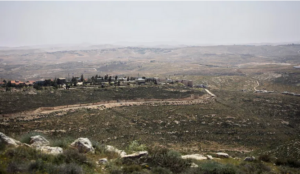Israel has declared record amount of West Bank land as state-owned in 2024

South Hebron Hills, West Bank, April 2024
Hagar Shezaf reports in Haaretz on 11 April 2024:
Barely three months into the year, 2024 has already seen a record amount of West Bank land declared as state-owned property. In addition, figures dating from 2018 to 2023 show that the Civil Administration has remapped approximately 24,000 dunams (5,900 acres) of state-owned land, most of them in areas deep in the West Bank – a move that may presage construction in settlements in those areas.
Since the start of the year, 10,971 dunams (2,743 acres) in the West Bank have been declared state-owned land, the figures show. The biggest bloc was 8,000 nearly 2,000 acres in the Jordan Valley. Another 650 acres were designated state property near Abu Dis, as were 42 acres near the Herodian National Park in the southern West Bank.
By comparison, data from the NGO Peace Now showed that the record year for declarations until now was 1999, when just 1,285 acres were designated. The organization’s data only begins in 1998.
Before construction plans can be approved, areas that were declared state-owned before 1999 are required to be remapped by the Civil Administration’s so-called Blue Line team. The majority of the remapping done over the last five years was in areas where there is no construction or little building has occurred.
The figures were made public following a freedom-of-information request submitted by the Kerem Navot, an NGO that monitors settlement activity, which also analyzed the data. According to the data, in 2018-2023, 1,070 acres were remapped in the South Hebron Hills area. It includes areas near the settlements of Pnei Hever, close to the Meitarim Industrial Zone, and Teneh Omarim. The latter is an area where several unauthorized outposts have been established on state land in recent years.
The largest areas in the West Bank to have been mapped include 576 acres near Karnei Shomron, most of which currently covers undeveloped land; 520 undeveloped acres near the pre-1967 border and the Palestinian villages of Nuba and Kharas; 435 acres near the settlement of Tekoa; about 630 dunams near the settlement of Shvut Rachel; and 400 acres near the Nahaliel settlement, large parts of which are also undeveloped.
A 2016 document states that the Blue Line team’s priorities should be areas subject to court disputes or that are in dispute between Palestinians and settlers or the state. The team is also supposed to focus on the West Bank settlement blocs (Gush Etzion, Ma’aleh Adumim, the Jordan Valley, Jerusalem, and Ariel), areas where educational institutions are set to be built, and other areas defined as urgent by the Civil Administration.
Recently, the Civil Administration announced that it intended to widen the jurisdiction of the Shiloh settlement to include the Ahiya outpost, which constitutes a step towards it being legalized. The move came after the Blue Line team completed its work in the area in April 2023.
Bezalel Smotrich, who in addition to being finance minister is a minister within the Defense Ministry responsible for the Civil Administration, has been working assiduously to win legal status for the outposts.
Earlier this week, it was reported that Smotrich had awarded “locality symbols” to the Mishmar Yehuda, Beit Hogla, Shacharit, and Asa’el – outposts that are in the process of becoming recognized settlements. A locality symbol entitles a settlement to government funds for its development. The move is in line with a cabinet decision made when the current government was established to formalize the status of 10 outposts as nine settlements.
Dror Etkes of Kerem Navot says he wasn’t surprised by the stepped-up activity. “As can be expected from this government, there has been a sharp increase in the past year in the public resources invested in the looting of thousands more dunams scattered in several areas deep in the West Bank, as well as promoting the possibility of construction on the thousands of dunams that previous governments looted for the past decades, although most of them have not yet been used,” he says.
This article is reproduced in its entirety
